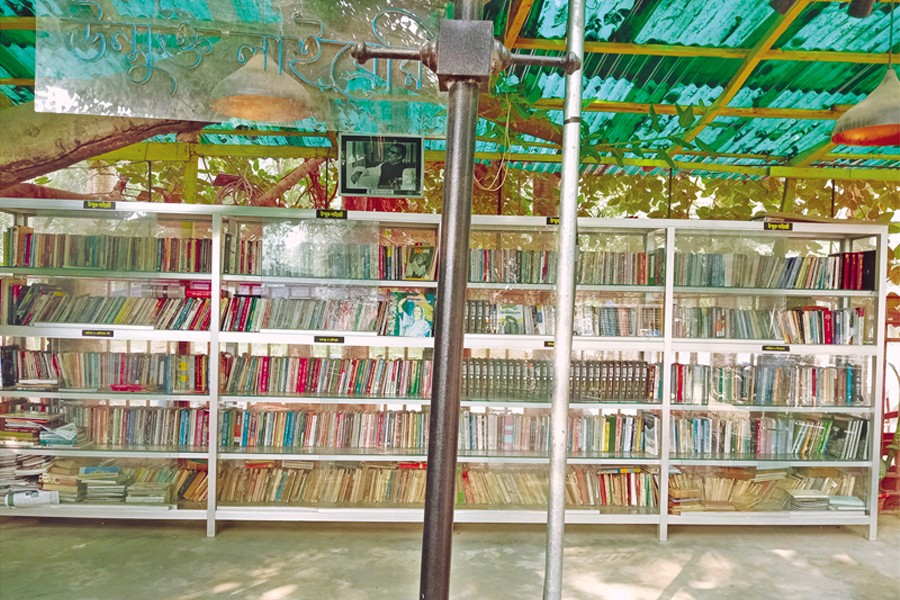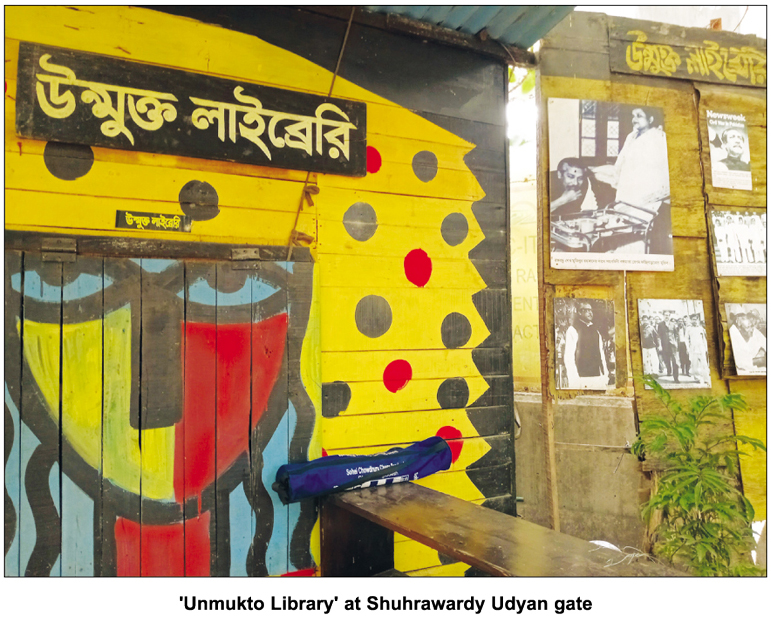 The main shelf
The main shelf Open Libraries bear cultural significance in society, and so does the one that exists at the centre of the city of Dhaka-at the entry of Suhrawardy Udyan, on the southwest of Raju Memorial Sculpture, or as people say, TSC.
The area is surrounded by trees and covered with an awning; therefore, even for a scorching noon, people find a soothing environment in this library.
Here in this library, people can sit through all day and read the book they are interested in while having a chit-chat with a loved one. There are seven yellow-coloured benches for readers to sit on and 4-5 seats built with bricks at the feet of Banyan trees.
 Spending hours in this library-reading one's favourite book while having a cup of coffee-will be an aesthetically pleasant experience for Bengali book lovers. Also, people can converse with others about the books they are reading, reflecting Amit and Labanya from Rabindranath Tagore's Shesher Kabita.
Spending hours in this library-reading one's favourite book while having a cup of coffee-will be an aesthetically pleasant experience for Bengali book lovers. Also, people can converse with others about the books they are reading, reflecting Amit and Labanya from Rabindranath Tagore's Shesher Kabita.
In a conversation with the writer, Tasnim Tanhar Trino-a junior year student at the University of Dhaka-said that the weekend for the library is Fridays and Saturdays and that it remains open the other weekdays unless there is a vacation.
Students of the University of Dhaka often come here, as it is located near the university campus. They hang around here while there are class breaks or while they are waiting for the down trip of their bus. The bookshelves contain four types of books: Literature and Novels, History and Politics, Bangabandhu and Liberation War, and Poetry and Children's Books.
The literature and novels segment contains various literary works, including foreign ones: 'The Kite Runner' by Khaled Hosseini and 'Letter to Jahanara Imam' by Begum Mushtarib Shofi are mentionable. Although the segment specifically mentions literature, there is some non-fiction, such as a book based on the New York Bengali Book Fair 2021. The most shocking addition is that there is almost no Rabindranath Tagore's or Kazi Nazrul Islam's work in this segment.
With that in mind, if the visitors are Bengali Classic Literature fans, they would be a bit disappointed. On the other hand, the library contains an extensive collection on the Liberation War, History, Politics, and Bangabandhu. Then again, visitors can bring their own books and enjoy them in an area that calls people to read, enjoy, and experience the moment.
The bookshelf is decorated with a picture of Bangabandhu Sheikh Mujibur Rahman at the top, and there is a dedicated shelf about him and the Liberation War. This shelf includes 'Bangabandhu Biswabandhu' (an album) by Bangladesh Shilpakala Academy and Bangladesh Photojournalist Association, 'Oshomapto Attojiboni' (The Unfinished Memoirs) by Sheikh Mujibur Rahman, 'Bangabandhu-r Shwapno' by Abul Kalam Azad, and many great books on the depiction of the Liberation War.
On the other side, the history and politics segment lacks diversity, showcasing 20+ copies of Sangbadpatra Shmarok Grontho by Obaidul Quader and Jonaki Publications. Despite the lack of diversity, this shelf does include some impeccable books: 'Cairo Trilogy-Palace of Desire' was one of them, although that was a translated piece by Nagib Mahfuz.
The poetry and children's books included classic poetry, such as Rabindranath Tagore's 'Shanchayita.' Still, there were some out-of-place books-Bengali Dictionary and Digital Bangladesh-which are not children's books, and nor poetries. All in all, these bookshelves often do not justify the 'category', but that does not mean that visitors cannot enjoy being here, considering that most visitors bring their favourite book to read in a calm place where the city is too crowded.
Considering other libraries in Dhaka, the environment-with mini plants of flowers and banyan trees-makes the place unique. The place does not try to be a modernised version of some old book's description of a perfect library; rather, it has its own aura that reflects those descriptions of libraries where people die to go. Sitting for hours at this library, reading a book of a favourite kind, and observing the people around makes a perfect scenario Rabindranath Tagore described introducing Labanya or Binodini.
If one passes the main bookshelf-or bookshelves that contain those four categories of books-they will find a place tagged "No Smoking Zone," which is a common thing considering every place has a sign like that and people still smoke; but, here is the magic-at the opposite side, before the bookshelves, if you calculate from the centre, there is another tag "Smoking Zone." It is surprising at a place in Dhaka where two opposite kinds of people can sit through the entire day reading books: one hates smoking, and another lives through smoking. Perhaps that is the true demonstration of Bengali literature: in one corner, there is Amit; in another corner, there is Feluda or even Devdas.
However, the most enchanting thing about the library-which probably reminds a person of a horror story, or an undocumented place every literature fan wishes to go, or a 'danger' signed place every adventurer dreams of seeing-there is an abandoned bookshelf, with a wood stick in front, written: "Fragile, handle with care." Yes, the bookshelf's front was a bit broken, but it has some refreshing books: Dan Brown's Robert Langdon Series, Yuval Noah Harari's 'Sapiens,' and some other classic novels. This place is on the left after anyone enters the library, but for having a bush in front of the shelf, people barely notice it.
Many literature enthusiasts are in this chaotic city searching for a serene place amid a chaotic day. To those, this open library opens the door to experience different lives and surprising moments or simply enjoy the book they have with them. Perhaps this way, this city will flourish with literary works like before, like the olden days, which we are proud of.
© 2024 - All Rights with The Financial Express
